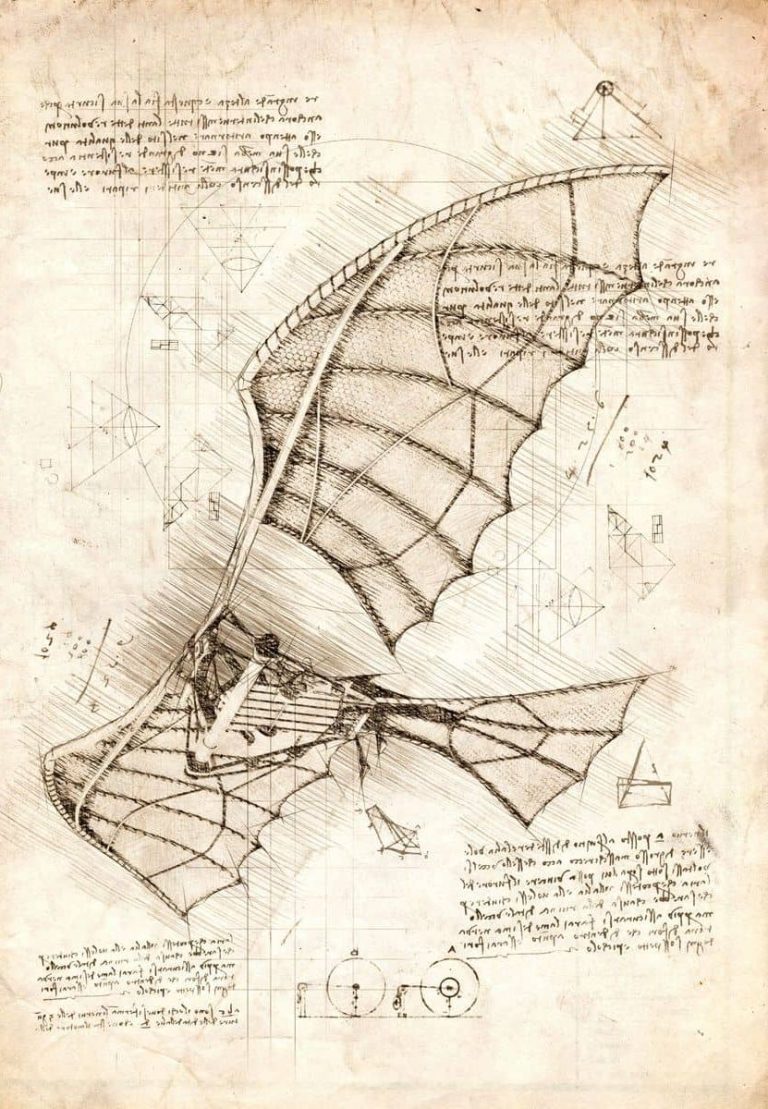The design /evolution process
Evolution is about change
Design is about change
Evolution is about a lot of very small changes over very long periods of time.
Design is about quite big changes over sometimes
very short periods of time.
The results of these two different processes appear to be similar. Things which we are told ‘evolved’, look very much as if they have been ‘designed’.
There is another similarity between these two
processes, which has emerged long after Darwin’s
‘Big Idea’. Evolution is about information. Since the discovery of DNA in the 1960s, we know that life depends not on chemistry but on information – the changes which fuel evolution are in fact small unintended changes in the coded information stored in the DNA of every living cell. It is that information which controls the chemistry of life.

Leonardo's design for a flying
machine
Design too is about information. Most design today is computer based (CAD = Computer Aided Design) and involves manipulating chunks of digital information. Even those who like myself still often work with pen and paper know that the sketch can be scanned and transformed into digital data, which can be copied, changed, updated and stored.
These two processes which might seem similar, are in fact utterly different. They are poles apart.
The raw material of evolution is chance – random accidental changes (‘mutations’) in the coded information which defines life, very small changes which may sometimes prove to be favourable and accumulate over long periods of time to cause very large changes, so it is said.
Design, in complete contrast, is based on intelligent thought – first of all establishing an overall concept or target, and then pursuing it with research, imagination, foresight and hard work.
Interestingly, most design tries to eliminate the element of chance, because human experience tells us accidents are bad, they are destructive, not creative. The car designer tries to anticipate everything that could possible go wrong with a particular component, to eliminate the ‘accident waiting to happen’.
Something else. These things which are said to have evolved are much more sophisticated in every way than anything which we have designed. They are often incredibly small, highly efficient, self-maintaining and repairing, self-replicating and sometimes exquisitely beautiful. An entire branch of human science (called ‘biomimetics’) is devoted to researching the natural world with a view to learning from it and improving human designs.
Isn’t that strange?
So what are these various changes that evolution suggests have worked their magic on the history of life on this planet?
Gallery study ‘the perfect copy’ takes a brief look at DNA and the coded information it contains. DNA is a ‘double helix’, like a ladder that has been twisted into a spiral. The critical components are the ‘rungs’ of the ladder, each of which contains two ‘letters’ or chemicals (nucleotides) known as ‘bases’. There are just four letters in all, known as A,T,C and G.

A simple model of DNA
The model shows the characteristic twisted ladder structure where the 'rungs' of the ladder each carry two letters of the DNA code.

It is this four letter code which stores the information which defines us as individuals, and which controls the processes of life from moment to moment. This information is constantly in use, which requires various sections of it to be copied. Sometimes the entire set of code (the ‘genome’) has to be duplicated, when the cell divides into two in the processes of growth and reproduction.
This code can be altered by attack from chemicals or radiation, but it is mainly in this copying and duplication that small errors or ‘mutations’ can creep in. DNA has its own remarkable proof-reading and error correction mechanisms, but even so small mistakes occur. This process has been studied in detail, and a number of different sorts of mutations identified and named.
One letter of code may be omitted (a ‘deletion‘ error) or altered (‘a substitution’ error). A letter may be added, two letters may be misplaced or copied more than once, or a segment of DNA may be flipped. Most extreme, sometimes all the DNA, the entire ‘genome’ is duplicated, so the organism’s DNA is doubled.
These are some of the mutations that evolution has on the menu to bring about long term change. Although our understanding of the role of DNA is being updated all the time, (eg the international ENCODE Project that has now moved to Phase 4) the textbooks still seem agreed that mutations are the key to evolution – no mutations, no evolution. So how do they work?
Most of these changes are very small and have no effect (see Process of evolution diagram HERE) A lot of them are not in the right area to be passed on to offspring. Of the ones which do have an effect, the majority (90%?) are damaging and there is a long list of problems caused by defective genes, including cancers. Large mutations are inevitably fatal. But occasionally, it is argued, a mutation may be helpful in some way, big enough to be effective but not big enough to be damaging. So evolution walks this tightrope between mutations that are not big enough to make a difference and so are discarded, and others which are too big and lead to disaster (see also HERE).
You have probably heard the expression “data corruption’ In the fields of computing and information technology, When unintended changes happen to computer code it is usually described as ‘corruption’– a programme has been corrupted, data has been corrupted. The corrupted data is useless and has to be replaced. By any standards, ‘mutations’ are essentially data corruption in the DNA of life. But it is claimed that this corruption, far from being fatal, is directly responsible for life on earth in all its diversity and magnificence. Does that make sense?
These changes happen at the level of one individual organism, amongst a population of maybe millions of similar individuals. Suppose we have one individual with an exceedingly rare helpful mutation. That individual has to survive to maturity and have offspring with the same mutation. If he gets eaten, end of story. If he survives, that small helpful characteristic must give his offspring so much of an advantage that they will survive and reproduce while others won’t; so that soon the entire population will have the same feature. That is 'natural selection' at work, and evolution moves on, supposedly, towards an unknown goal.
One vital ingredient is missing from this scenario: new information.
Not information that is very slightly different or garbled or back to front, or copied too many times or whatever, but additional brand new and coherent information that has never been seen before.
Evolution is not just about changes in information, it is about a huge overall increase in information. If you take one of the smallest forms of life (not the ‘simplest’, because simple forms of life do not exist), a tiny bacteria might have a genome (total information content) of 500,000 base pairs. Remember a ‘base pair’ is one of the rungs on the DNA ladder, a ‘pair’ because it holds two letters of code. Some bacteria are even smaller, but they depend for their survival on a larger ‘host’ organism to keep them alive. So a small bacteria may have half a million base pairs of information. Compare that with the human genome, which has well over three billion. You do the maths! So to get from a small bacteria to a human being requires a massive increase in information. The same applies to all more complex life forms.
Even the smallest independent life form needs a huge amount of information to survive and reproduce. There is no evidence whatever that any simpler form of life has ever or could ever have existed.
This new information is not nonsense, garbage or ‘Junk’ DNA, but highly specific information on entirely new body plans and amazing features like the sonar of the dolphin and the whale (see HERE) the echo-location of bats, the flight of birds and insects, the 20 or so genes that describe the peacocks feathers (see HERE), the human brain with its network of 100 billion neurons (see HERE) and so on. Where did this information come from? Where does any information come from?
Where did the original information which made life possible come from?
I have generally chosen (as did Darwin) not to deal with the origin of life, the essential first step before evolution can even begin, but it remains a huge problem facing materialistic explanations of life. ‘Origin of life’ (OoL) researchers are still completely baffled by the information requirements of life. (see Abiogenesis HERE) Earlier pseudo-scientific fairytales involving lightning strikes on some sort of pond of primeval soup are comically inadequate to explain what we now know about life. That is because, amongst other things, they ignore the information requirements of even the smallest life form.
In human experience, in science, there is only one known origin for information – an intelligent mind.
NEXT What's the idea?
We do not use cookies on this website. We do not collect any of your personal details, and our list of subscribers is not shared with any third party.
Intelligence and purpose in the natural world
We need your consent to load the translations
We use a third-party service to translate the website content that may collect data about your activity. Please review the details in the privacy policy and accept the service to view the translations.
